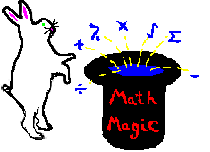

A. Usually, it is easier to simplify trigonometric expressions to sin A, cos A, or tan A. In keeping with this concept there are certain values of A that are basic: 0; p/6, p/4, p/3, and p/2. For this reason, the following table should be memorized:
| 0 | p/6 | p/4 | p/3 | p/2 | |
| sin A | 0 | 1/2 | \/2/2 | \/3/2 | 1 |
| cos A | 1 | \/3/2 | \/2/2 | 1/2 | 0 |
| tan A | 0 | \/3/3 | 1 | \/3 | undefined |
Note: These values are only expressed in radians and only in the first quadrant. If you want the values as expressed in degrees see the section on changing radians to degrees.
Note: Also, 1/sin A = csc A; 1/cos A = sec A; and 1/tan A = cot A. Therefore, to find the values for csc A, sec A, and cot A, simply use 1/value in the above chart.
1. These are the only values you need to know. Once you get out of QI, the values repeat themselves (see below on quadrants) only the sign might be different.
2. To find values from other quadrants, find its corresponding value from the first quadrant before computing.
Ex [1] 11p/6 from QIV = p/6 in QI
Ex [2] p from QII = 0 in QI
Note: If you need additional help on this email me.
B. Sometimes, a number sense question will ask for answers that are not related to the first quadrant. A quadrant is a section of a graph. The upper-right hand section is the first quadrant or QI, the upper-left hand section is the second quadrant or QII, the lower-left hand section is the third quadrant or QIII, and the lower-right hand section is the fourth quadrant or QIV.
p/2
|
|
QII | QI
|
p --------------------- 0
|
QIII | QIV
|
|
3p/2
1. When working with angles, it is always helpful to know what quadrant we are talking about. The reason is we use quadrants to tell us if the sign of the answer will be negative or positive. Use the following chart to help:
| QI | QII | QIII | QIV | |
| sin A | + | + | - | - |
| cos A | + | - | - | + |
| tan A | + | - | + | - |
Ex [1] sin (11p/6) = _________.
Notice 11p/6 is in QIV, therefore the answer is going to be negative.
Its corresponding value is p/6 in QI, so the answer is -1/2.
Ex [2] tan A = 1, A 0 QIII, A = _________radians.
For tan A = 1, we know that A = p/4, but we need the corresponding value from QIII.
The value is p + p/4 = 5p/4.
The answer is 5p/4.
C. Many times a question will say: sin A = a/b (where the values of a and b are given) and ask you for tan A or cos A. For problems like this is it helpful to know common Pythagorean triples and also to understand what sin, cos, and tan mean:
sin A = opposite side/hypotenuse
cos A = adjacent side/hypotenuse
tan A = opposite side/adjacent side
Ex [1] If we have a right triangle with sides 3, 4, and 5 and sin A = 3/5 then cos A = _________.
First, it is important to note that on a number sense test, the question will not give you the sides 3, 4, and 5 like this example.
From above, we know that the numerator is the opposite side and the denominator is the hypotenuse. So the cos A would have to be the other side divided by the hypotenuse or 4/5. So cos A = 4/5.
To find the tan A, we need the opposite side as the numerator which is 3, and the adjacent side as the denominator which is 4. So tan A = 3/4.
D. There are MANY properties in trigonometry that need to memorized if you want to do well on the number sense tests. Below are only a few of the BASIC trig properties. Note that this list is not exhaustive. There are others which can be found in any trig textbook. These are just the most common found in number sense tests.
| cos (-A) = cos A | sin (-A) = - sin A | tan (-A) = - tan A | tan A = sin A/cos A |
| sin 2A = 2sinAcosA | cos 2A = cos2 A - sin2 A | cos 2A = 2cos2 A - 1 | sin2 A + cos2 A = 1 |
| sin2 A = 1 - cos2 A | cos2 A = 1 - sin2 A | 1 = sec2 A - tan2 A | sec2 A = tan2 A + 1 |
| tan2 A = sec2 A - 1 | 1 = csc2 A - cot2 A | csc2 A = cot2 A + 1 | cot2 A = csc2 A - 1 |